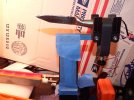For those who don't know who is
Man'ko.
Bogdan Manko is an individual sharpening system inventor from Ukraine. He has spent years to research and develop such features as:
- high-precision sharpeners with the blade above abrasive
- always-horizontal abrasive holder
- rigid pantograph arms
- zero-gravity guide rod
As you have noticed, he does not speak English. I will try to explain here what he tried to say.
His clamp design is similar to KME split piece jaws. The biggest difference is small spacers in the center of both jaws. These spacers let align the blade to have uniform angles on both sides, even if the factory grind is uneven. The spacers also give an extra contact point for distal taper blades. With all due respect to Bogdan, I think this design is good only for "blade above abrasive" class sharpeners where magnets are primary, and the secondary clamp does not need versatility. But for traditional sharpeners, these clamps are not strong enough and not deep enough to secure many blade shapes, especially distal taper.









